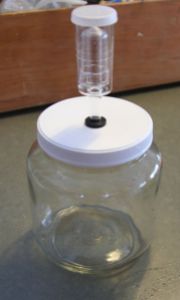 I’m expanding the repertoire this year by joining the fermenting trend. It’s a bit of an odd choice for me because I don’t really like pickles or sauerkraut. But I’m just sure that, like beets, I will love all things fermented once I’m doing it myself. And it seems like fun.
I’m expanding the repertoire this year by joining the fermenting trend. It’s a bit of an odd choice for me because I don’t really like pickles or sauerkraut. But I’m just sure that, like beets, I will love all things fermented once I’m doing it myself. And it seems like fun.
Pickling crocks are really cool, with these half-circle weights that help keep the vegetables under the brine. But they’re also really expensive– well over $100. So when I saw this “fermenting vegetable master” at the Cultures for Health website, I jumped. I like the idea of the airlock, which means gases can get out without any bacteria getting in and a “cleaner” ferment.
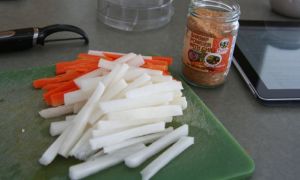 I got busy right away making a batch of kimchi. Now, kimchi is something that I think I don’t like, but a friend brought some to a cabin this summer. She pulverizes it in her food processor and uses it as a real condiment, not a side dish. We had it on eggs and it was delicious!
I got busy right away making a batch of kimchi. Now, kimchi is something that I think I don’t like, but a friend brought some to a cabin this summer. She pulverizes it in her food processor and uses it as a real condiment, not a side dish. We had it on eggs and it was delicious!
I read several recipes online and determined the one I wanted was at The Kitchn blog, here. I did add carrots to it, which I made into matchsticks like the daikon radish.
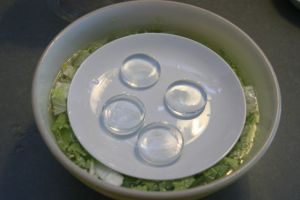 The basics of fermenting is that you submerge vegetables in a brine and leave them there until all the enzymes have worked their way through and preserved/pickled them. Then you put them in a jar in the fridge and it will last awhile.
The basics of fermenting is that you submerge vegetables in a brine and leave them there until all the enzymes have worked their way through and preserved/pickled them. Then you put them in a jar in the fridge and it will last awhile.
This recipe called for salting and draining the cabbage up front, washing it three times and getting all the liquid out (as much as possible). This meant that there wasn’t really brine (or maybe I’m thinking I didn’t press on it enough– it seems with sauerkraut you really have to pound the stuff until a brine comes up). Other recipes called for a brine to be added at the end and so I made a quick brine (2 Tbs salt dissolved in 4 cups water) and poured in enough to cover the veggies. I also had bought these nifty glass disks that I could use to submerge the veggies.
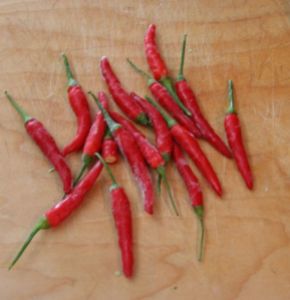 Although I found these great fish flakes at the Asian market (along with the Daikon radish and the Napa/Chinese cabbage), I did not see Korean chili pepper flakes, although there were these giant containers of red pepper flakes that would have worked– but seriously, I do not need that many red pepper flakes. And I have thai chili peppers in the freezer, so seeded some of them and included a few whole to give some color. Usually kimchi is bright red, but mine is more cabbage colored.
Although I found these great fish flakes at the Asian market (along with the Daikon radish and the Napa/Chinese cabbage), I did not see Korean chili pepper flakes, although there were these giant containers of red pepper flakes that would have worked– but seriously, I do not need that many red pepper flakes. And I have thai chili peppers in the freezer, so seeded some of them and included a few whole to give some color. Usually kimchi is bright red, but mine is more cabbage colored.
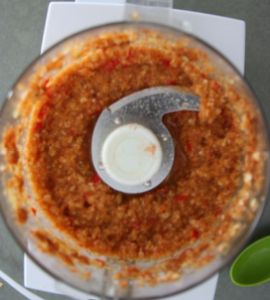 I left the batch on the counter for five days. The liquid level did rise to the top of the jar, so if it had started out full, it would have overflowed (not a bad thing). I clearly didn’t need as much liquid as I added. It didn’t bubble and eventually the liquid level went back down some. I went on a trip after five days so put it in a quart jar in the fridge before I left.
I left the batch on the counter for five days. The liquid level did rise to the top of the jar, so if it had started out full, it would have overflowed (not a bad thing). I clearly didn’t need as much liquid as I added. It didn’t bubble and eventually the liquid level went back down some. I went on a trip after five days so put it in a quart jar in the fridge before I left.
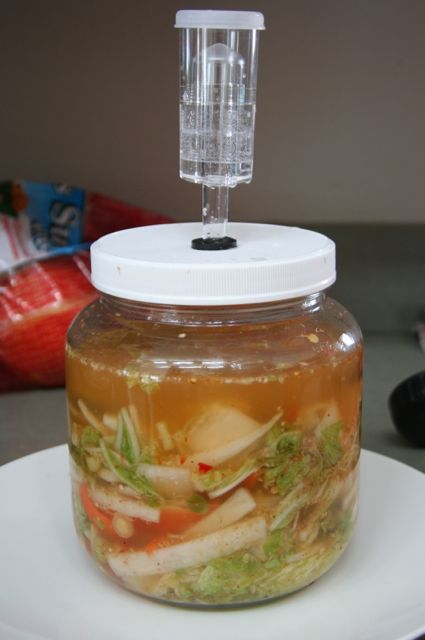 It is yummy. It has some kick, but is not too spicy or too salty, and you can taste all the flavors. It is kind of fresh tasting!
It is yummy. It has some kick, but is not too spicy or too salty, and you can taste all the flavors. It is kind of fresh tasting!
I plan to do more experimenting and I’m especially looking forward to fermenting with whey from homemade cheese. If you have good sites for recipes, particularly less common ferments, do let me know!


